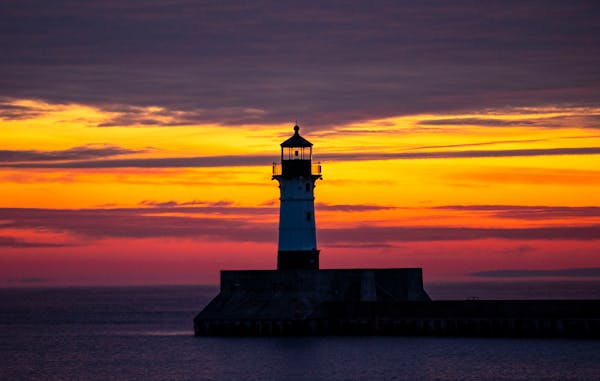LAKE COUNTY, Minn. — A full-sized replica of Split Rock Lighthouse's third-order Fresnel lens — like the one that occasionally casts its beam out over Lake Superior — is among the highlights of the biggest update to the popular state park's on-site museum's programming since 1997.
The new exhibition in the visitors' gallery space, which opens later this month, also includes the wheel of the sunken Madeira, stories from the Indigenous people who have long lived on Lake Superior and tales of the lighthouse keepers of yesteryear — complete with a cap worn by the first, Orren Young.
The star of the show, though, is a variation on the prismed lens that casts the beacon light that captains would have kept a keen eye on in this landmark's heyday.
The replica of the full-sized third-order Fresnel lens turns slowly in the heart of the gallery in the visitor center and is capable of sending out one white flash every 10 seconds — a pattern and pace that was the characteristic, or signature style, of Split Rock Lighthouse, making it identifiable to crews on Lake Superior during the more than 50 years it was active.
At eye level, the acrylic paneled lens delivers a big impact.
"We wanted that to be like the statement piece," said Hayes Scriven, the lighthousekeeper who lives on the grounds with his family.
Like its counterpart lens, which still turns in the lighthouse but isn't often lit, the replica is more than 5½ feet tall, 7 feet in diameter and weighs 650 pounds. It has 252 prisms that shine and make small rainbows in the museum space. If needed, Scriven said, it could replace the current lens. The Fresnel lens, which was added in 1910, is available for viewing at the top of a 22-step spiral staircase in the lighthouse, but from a distance.
The exhibition is temporarily behind closed sliding doors, but will be unveiled May 26 during North Shore Community Night. The lighthouse beacon will be lit for the event, like it was recently to honor the late Gordon Lightfoot, the singer-songwriter of the Lake Superior ballad "The Wreck of the Edmund Fitzgerald." The beacon is traditionally lit on the anniversary of the sinking of the Edmund Fitzgerald in a ceremony honoring the lost crew members.
Split Rock Lighthouse is the most visited historic site run by the Minnesota Historical Society. According to the DNR, Split Rock Lighthouse State Park — which surrounds the lighthouse — is among Minnesota's most-visited state parks.
The Madeira is among the catastrophes of the 1905 November gales that led to the building of the lighthouse. The schooner was in the tow of a steamer, the SS William Edenborn, in the early morning of Nov. 28. The harsh weather affected dozens of ships during what was later billed as the worst storm in the history of the Great Lakes, according to the historical society. Cut loose, the Madeira crashed into Gold Rock Point, a jut of cliffs a half-mile north of where the lighthouse was built five years later. All but one member of the 10-man crew lived — thanks to Fred Benson, who climbed up the rocks and tossed down a rope to his mates.
The wheel was pulled free of the wreckage and was on display for decades at the SS Meteor, a whaleback ship museum in Superior, Wis. Megan Meyer of Superior Public Museums handed it off to the Split Rock crew because it is part of the lighthouse's origin story — a piece she knew needed to come home, Scriven said.
The round wheel with cracks in the wood sits in front of the deep green underwater video footage of divers at the site where it sank. Some days, the 22-acre debris field is visible for kayakers passing over it.

In Grand Rapids, Itasca Pride is planning its first event, but there is already pushback
One person shot at YMCA in Coon Rapids

BCA says man pointed pistol-style BB gun at officers before he was shot in Woodbury

Former diversity worker sues University of Minnesota after firing over swastika photo

